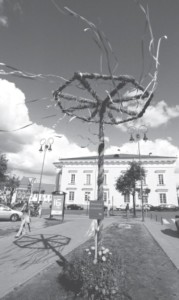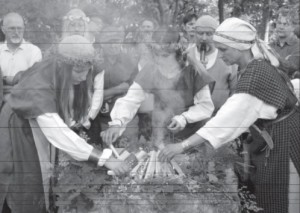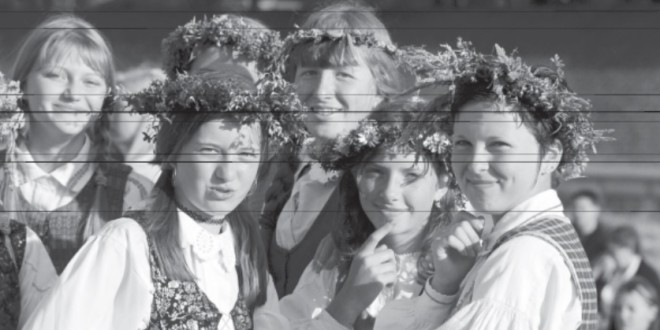![]()
In Lithuania, the midsummer night and day are still celebrated with rituals and ceremonies whose origins date back to pagan times.
ROMANCIENT TIMES, PEOPLE MARKED THE time of the return of the sun and the year’s longest day. In olden times in Lithuania this day was called Rasos or the “feast of the dews.” When Christianity was established, the name was changed to the feast of St. John the Baptist, commonly known today as Joninės.
The rituals of the longest day were closely related to agrarian ideas and notions. The main aim was to protect the harvest from natural calamities, evil souls, witches, and midsummer visitors like wind, hail, downpours of rain and thunder. The ancients worshipped the great goddess Lada and the god Perkūnas, the ruler of thunder and lightning. From May 25th till June 25th men visited taverns while women and girls danced in the fields holding hands, sang and sacrificed white hens.
The noted ethnographer Norbertas Vėlius wrote that the “feast of the dews” binds with the feast of the god of thunder honoring the embodiments of all kinds of powers. Men’s wrestling, a demonstration of their strength can be linked to the feast of the god of thunder.

The sun is the first to be addressed, because at this time of year she is most active and most rites are carried out in her honor. This is a holiday allotted to the gods of heaven. The Lithuanian historian Simonas Daukantas (1793–1864) called the feast of St. John the “feast of the wreath,” and asserted that in ancient times it was celebrated during fourteen days.
In the 15th century, visitors to Lithuania wrote that in Vilnius, the celebrations took place in the eastern section of the city, the place of the present day Rasų Cemetery. Bonfires were lit on hills and in dales. People danced, sang, ate and drank. On Joninės a special role was granted to the sun. The sun is constantly mentioned in songs sung on the longest day of the year.
On this ritual day, farmers paid special attention to water’s special powers in reviving soil and making it productive. Omens and prognistications were carried out with water, people washed themselves and their animals. Special attention was paid to the dew because it revives plants at night. At sunrise farmers made their way around the fields, pulled a branch which brushed the dew, and dropped it into the soil to cause a good harvest. Maidens tried to get up before sunrise to collect the dew and wash their faces with it to make them bright and beautiful. They would also get up at night, go outside to wet their faces in the dew and returned to bed without wiping their faces dry. If that night they dreamt of a young man bringing them a towel, they hoped that he would be the one they would marry. Country sorceresses, during that night dragged a towel over dewy grasses, collected the dew, and watered the cows with it in order to increase their milk production.
Various plants and herbs were collected on the eve of Joninės because it was believed they posses magic powers to heal, bring luck, and foretell the future. This was an ancient ritual practiced mainly by women. Roses, common daisies, especially the herb St. John’s Wort and numerous grasses were some of the main plants collected at this time. The ethnographer Pranė Dundulienė asserts that nine plants with healing powers were called kupolės, or plants of Joninės. A maypole, decorated with flowers and greenery was also called kupolė. Folklore shows that Kupolė was the goddess of plants, living in aromatic plants, blossoms or in buds in summer and in snowdrifts in winter.
In Lithuania Minor, even in winter before Joninės, women made haste to collect medicinal herbs, with the belief that after June 24th all herbs lose their healing powers. Girls returned to the village after picking flowers and singing, wreathed the kupolė and added colorful fluttering ribbons to it. This maypole was set at the far end of the village, near the grain fields. It had to be defended during two days and nights from young men who tried to steal it. After saving the pole, the girls removed the decorative herbs and grasses and divided them amongst themselves because these herbs had special protective powers against evil spirits and illnesses.
In some regions, bunches containing nine plants were gathered by women on the eve of Joninės. Some of the plants were fed to animals before midnight, so they would be protected from evil eyes. Bunches of St. John’s Wort were placed behind pictures of saints. If this bunch did not wilt fast, it was believed that it will be a lucky year. Other herb bunches were kept till Christmas, the winter return of the sun, then fed to cows so that they would be healthy and good milkers. Cows’ udders were washed with a decoction made with St. John’s Wort. Bunches of nine herbs were kept in barns through Christmas. Other bunches of dried herbs were used to smoke sick people and animals.
It was believed that wreaths concentrate perpetual life’s forces and are symbols of immortality and life. There were many omens and prognostications associated with wreaths during the longest summer night:
Walk around three fields and gather bunches of nine flowers, twine a wreath and place it under your pillow. You will marry the man, who in your dream comes to take away the wreath. At midnight, twelve wreaths were dropped into a river and observed if they were pairing off. If no pairing off occurred, there was to be no marriage that year. Near the river Nemunas, wreaths were dropped in the water, only when the river was calm and observed to which direction they drifted. Matchmakers would come from that direction. Releasing the wreath with the current, it if it is caught by a young man, the maiden will be his. Should the wreath float away without being caught, the maiden will keep that wreath all year in her dowry chest, as a symbol of luck and health.
In the seacoast region, all during the night, young men and women twined wreaths from ferns, placed lit candles on them, and set them in streams. Should both their wreaths swim together, they believed that they would marry that year.
In some regions, wreaths twined during the night of Joninės were placed at crossroads with the belief that one’s future will be seen in a dream.
Seacoast fishermen did not go out to fish on Joninės or even several days after it. According to them, the sea lurks for sacrificial lambs on these days.
The rites of this day continued till sunrise around bonfires. The site selected for ritual bonfires was always in the most beautiful area, on hills, on river shores and near lakes. In some regions bonfires were lit on future grain fields and under linden trees.
Those who are not fond of socializing on the eve, hurry and gather along lake shores, light bonfires, place burning poles covered with tar into trees, so that there would be light all night long until sunrise. Special decorated wheels were lit and were rolled down hillsides; this symbolized the sun’s moving away from the earth and at the same time a request for her return.
In ancient times, the ritual fires were lit by senior priests, vaidilos. The fire was started with sparks coming from rubbing dried roots of medicinal herbs or from flying sparks when striking flint stones. Such fires would protect from epidemics, illnesses, poor harvests, hail and lightning.
Eggs were thrown into the fires and animals sacrificed. Later, straw dolls were sacrificed in place of animals.

The ritual bonfires were built up to throw their light over a large area of fields, to assure a big autumn harvest. On the eve of this feast day, home fires were put out and new fires were lit using glowing coals from the ritual fires of that day. It was believed that these ritual fires had special powers, which would protect from misfortunes, bring health and harmony to the family. It was important for newlyweds to light the fire in their hearth with the coals of the miraculous ritual fire. Such a family would be blessed, live well and in total harmony.
Pranė Dundulienė in her book Fire in Lithuanian Folk Culture, writes that jumping over a bonfire or around it had magic meaning. Ritual fires cleansed both physically and psychologically. Sick adults and children were brought to the ritual fires and were pulled through the fire, with the belief that they would be healed. Jumping over the fire was carried out with the belief of making better health, increasing body strength for hard summer labors, and assuring better growth of grain and flax. Ritual fires’ ashes and smoldering coals had special powers to increase the harvest and protect it from natural calamities. The coals were dug under in fields, ashes were sprinkled on crops to assure good crop yields. To keep weeds from growing in grain fields, the wood splinter remains of the ritual fires were tied to the plowshare when plowing the fields.
In East Prussia, the common tradition was to throw herbs and flower wreaths into the bonfires. Weeds were also thrown into the fires with the belief that there would be fewer weeds next year.
The most archaic tradition of this day is tall poles with wheels at their top, set on fire. The wheel symbolized the primitive farmers’ attitudes to the sun or her travel cart. This tradition is related to myths about the sun’s travels by cart or by boat. The tradition of boating on lakes and rivers in flower- and wreathdecorated boats, in which a fire was lit, symbolized the floating sun and was widespread throughout Lithuania.
Joninės is connected with summer weddings and their rituals which were bound to affect family living and population increases. Should a pair become friends this night, there would definitely be a wedding.
The midsummer night is the shortest night of the year, filled with bird sounds and luxuriant vegetation. Darkness substitutes light unnoticeably, the night is full of miracles due to fire reflections and shadows. It was believed that activity during this night by supernatural creatures or female witches was ill disposed towards men, animals and plants. To keep animals from their malevolent actions, they were put in barns before sunset and were fed bread with salt for protection. Mountain ash branches and wheat sprays were hung on door posts for protection against evil spirits. In some regions, clogs were placed in front of a mirror. Witches would step into the clogs and run away upset by their frightful image in the mirror.
In Samogitia, Šatrija was the most famous witches’ hill, where during the night of Joninės, witches party and rage all night and invent all kinds of enchantments. This is why one could not do without the “burning of witches.” Young people tied a barrel filled with tar and sawdust to a high pole, sprinkled it with salt so that the witches would crackle. The barrel was set on fire while the young people sang and danced merrily. Next morning the cow herd was driven through the remaining ashes, with the belief that witches will no longer be harmful.
During the night of Joninės, the miraculous fern bursts into bloom. It is difficult to catch sight of this bloom, however this difficulty can be overcome by going to the forest the day before, cutting down a mountain ash, pruning the branches and cutting off the top. Then pulling the tree backwards, walk about one hundred steps without looking back, toward the side to which the cut tree fell. Look back after the hundred steps and then you will see the devil sitting stuck in the ash tree. The devil will ask for your help to get off the tree and for your help he will tell you where to find the blooming fern. When you locate the blooming fern, ghosts will attack with butting horns, whirlwinds will howl, and cats will cry. Then take a cane made of mountain ash, draw a circle around you with it, spread a linen cloth and stop being afraid. The fern blossom will fall on the cloth. Some say that the fern bloom is like birch dust, others describe it as round and white like the scale of a fish.
This article was adapted from the Anthology of Lithuanian Ethnoculture. © Lithuanian Folk Culture Center, Vilnius, Lithuania.
 DRAUGAS NEWS Lithuanian World Wide News in English
DRAUGAS NEWS Lithuanian World Wide News in English
